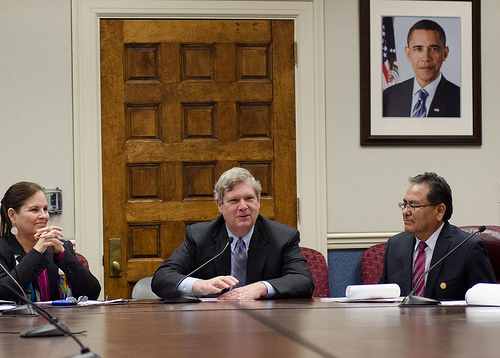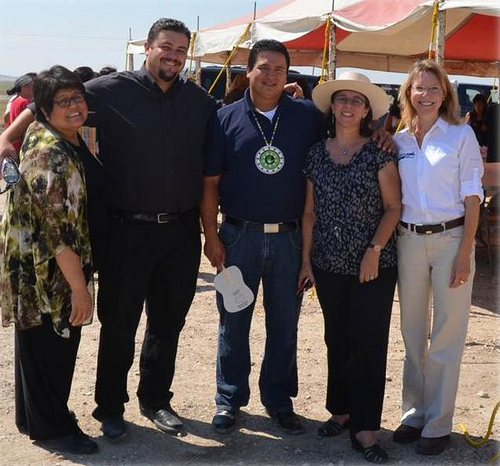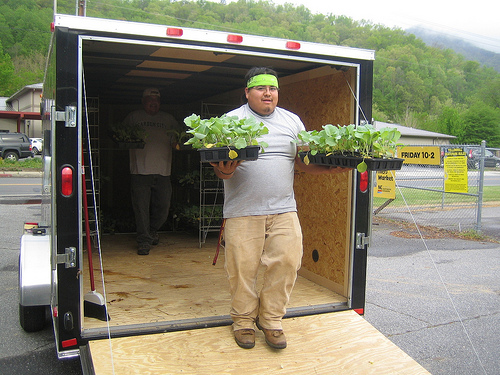
U.S. Department of Agriculture and American Indian Higher Education Consortium Leadership Group Winter Meeting, at the USDA Whitten Building, Williamsburg Room, in Washington D.C.
Speaking to the presidents of tribal colleges from across the nation at the Agriculture Department last week, Secretary Tom Vilsack expressed his commitment to support Tribes and further strengthening the government-to-government relationship. Read more »
The thought of having to hand-carry a honey bucket, (a five gallon pail filled with human waste) out of your house and dump it to an outdoor common collection container in winter temperatures that drop to -55 °F, is an unpleasant scenario. For some residents in the community of Lower Kalskag, and other rural Alaskan communities, this is a reality. They have no indoor plumbing, and no indoor hot or cold running water.
The community of Lower Kalskag, Alaska, is remotely located 350 miles west of Anchorage in a persistent poverty area. This small, predominantly Alaska Native community has a population of around 280 and roughly fifty percent of its homes still lack adequate sanitation systems. The lack of sanitation services is a dire health and safety issue faced daily by a number of rural Alaska residents. Read more »

A member of the Mississippi Band of Choctaw Indians removes the kernels from a corn of cob, one step in the hominy-making process.
For special meals like those on birthdays and Christmas, members of the Mississippi Band of Choctaw Indians include hominy on the menu—but hominy, essentially dried corn kernels, is expensive to purchase. Read more »

Federal partners working with Thunder Valley CDC: Left to right: Guadalupe M. Herrera,HUD Region VIII Sustainability Officer; Scott Moore, Thunder Valley CDC Project Coordinator & Architect; Nick Tilsen,Thunder Valley CDC Executive Director; Shelley Poticha, Director of the HUD Office of Sustainable Housing and Communities, and Christine Sorensen-South Dakota USDA Rural Development staff.
South Dakota USDA Rural Development State Director Elsie Meeks joined the Thunder Valley Community Development Corporation (CDC), and other consortium members recently on the Pine Ridge Indian Reservation of southwestern South Dakota to discuss next steps for the Oyate Omniciye | Oglala Lakota Plan. The regional planning process and the collaboration of a broad cross-section of regional stakeholders have created a regional plan for sustainable development and acts as a tool to begin implementation. One of the 12 initiatives identified in the Plan includes the creation of a Regional Planning Office. State Director Meeks attended the recent consortium meeting regarding the Regional Planning Office, stating “The planning team assembled by Thunder Valley CDC and diverse membership of the consortium have created a framework for sustainability; a regional plan that will allow for a coordination of resources and support.” Read more »
Thinking outside the box proved to be a winning solution when the U.S. Forest Service and the Caddo Nation joined forces to investigate and identify archeological sites on national forests in Texas and Louisiana.
In 2009, Barbara Williams, heritage program manager for the National Forests and Grasslands in Texas, faced the daunting task of uncovering evidence of historic and prehistoric artifacts buried in the loamy soil of the Davy Crockett National Forest and Sabine National Forest in the deep East Texas piney woods.
So the forest reached out to the Caddo Nation of Oklahoma, whose historic homeland was in the forests of East Texas. The Tribe partners with the Southern Region for training as heritage paraprofessionals and employment on the region’s national forests. Read more »
Tags: Arkansas, Caddo Nation of Oklahoma, Davy Crockett National Forest, Florida, Forestry, FS, Kisatchie National Forest, Louisiana, National Forests and Grasslands, Oklahoma, Ozark-St. Francis National Forest, Sabine National Forest, Texas, Tribal
 Forestry
Forestry

Volunteer George Welch unloads Garden Wagon plants.
When members of the Eastern Band of Cherokee Indians can’t make it to their local extension office, their extension office comes to them—with a gift of better health through home gardening. Read more »




